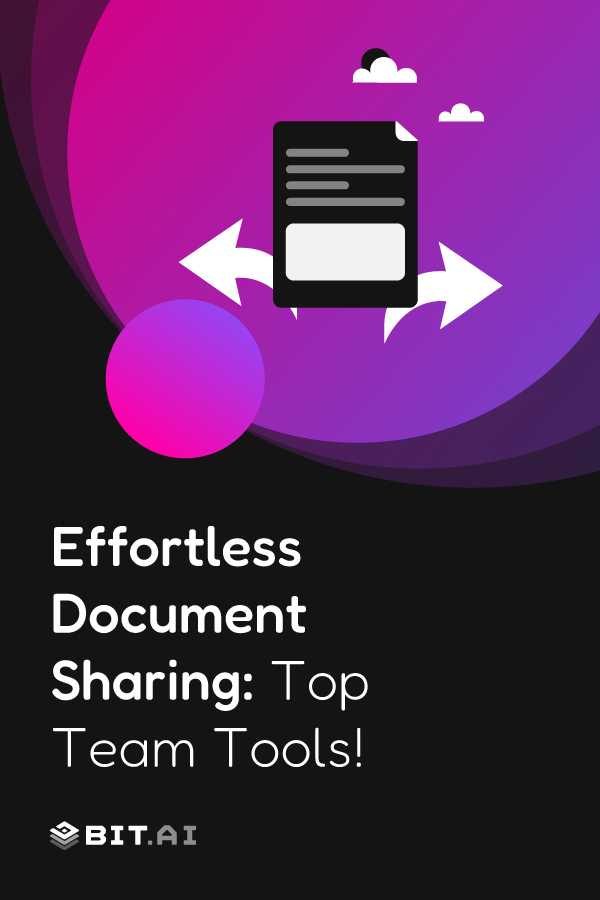Did you know that 70% of employees believe poor collaboration hinders productivity and wastes time?
Suppose you’re about to kick off something amazing with your team, be it a campaign, a client proposal, or a whole new product launch. However, when one person updates the document, the other person misses it. Suddenly, there are multiple drafts of one single document floating around, lost emails, and mish-mashed feedback. By the end of the week, you’re left juggling five different drafts, none of which are quite right.
Does this sound familiar to you?
In today’s remote and hybrid work environments, this kind of chaos is all too common. But it doesn’t have to be this way. Real-time document collaboration tools are here to help. They keep your team connected, your files organized, and your workflow smooth—no matter where everyone is working from.
So, without further delay, let’s take a look at what makes these collaboration tools effective, what features to look for, and which collaboration tools are trending in 2025. By the end, you’ll know how to improve teamwork, keep all your files in one place, and say goodbye to the chaos of multiple versions and endless email chains.
What are Team Collaboration Tools, and Why Do We Need them More than Ever?
Imagine a team collaboration space where everyone can brainstorm, edit, and comment on, and collaborate with documents in real time from anywhere – that’s where a team collaboration tool shines! Team collaboration tools are great because they combine chat, file sharing, collaboration on documents, and project management execution into one easy-to-use platform.
With real-time collaboration, everyone can stay on the same page, which makes teamwork easy and smooth.
However, why do we need collaboration tools so much in 2025?
This is because the nature of work has greatly changed. Teams are often spread out across different cities, countries, and even time zones. Remote work has become a normal part of life for many organizations.
With tight deadlines, multiple projects, and lots of tools in use, it’s easy for things to get confusing or for people to miss out on important updates. Team collaboration tools help solve these problems by bringing everyone together, whether working from home or in the office. These tools keep information and updates in one place, make it easier to share ideas, and help everyone stay in the loop.
One important thing to note down here is that these collaboration tools are not just for remote teams—people working in the same building also use these smart platforms to speed up their work and avoid mix-ups. For busy teams handling marketing campaigns, proposals, or product launches, collaboration tools let everyone work together smoothly and keep projects moving forward.
So yes, collaboration tools are absolutely important. Now, let’s move further to explore some of the checklists you follow while choosing an ideal collaborative software for you and your team to make your work smoother.
🚀 Turn scattered documents into one organized workspace with Bit.ai.
Checklist for Choosing the Perfect Team Collaboration Software
When it comes to choosing a perfect team collaboration tool, there are some basic features that each team should consider, whether it is remote, hybrid, or in-office. Here’s a checklist of must-have features to look for before choosing a collaboration software.
1. Real-time Document Collaboration
Imagine that your whole team is working on a document all at once. You will see comments appear instantly, you will see edits happening live, and there’s no one left wondering, “Is this the most up-to-date version?” There’s no need to email attachments back and forth or dig through threads to find the right file. This is the heart of what document collaboration tools do best. Real-time collaboration helps everyone stay on the same page, feedback happens instantly, and things keep moving forward without any confusion or delays.
2. Smart Content Organization
Collaboration isn’t just about editing documents; it’s about not losing your mind trying to find them later. The right collaboration tool should have organised workspaces to keep all files, notes, and assets in one place, so your team can quickly find what they need. No more hunting through emails or folders, everything lives in a structured, easy-to-navigate workspace, which saves time and reduces chaos.
3. Seamless Integrations
The best team collaboration software should connect with the apps your team already uses, so you don’t waste time switching between tools. Look for integrations with platforms like Google Drive, OneDrive, Dropbox, Figma, GitHub, Trello, Miro, YouTube, Vimeo, and Flickr. Whether it’s embedding charts, videos, code snippets, or files, these integrations bring all your content together in one place, keeping workflows smooth and teams fully aligned.
4. Integrated Task Management
Good teamwork goes beyond just talking—it’s about getting things done. A great collaboration tool should let your team create to-do lists, assign tasks, set deadlines, and track progress—all in the same place where you chat and share files. It keeps everything connected, so your team can plan, work, and stay organized without jumping between apps.
5. Security Controls
Regardless of the type of project you’re creating, either an internal doc or a report that will be shared with clients, you will want to have control over who can view, edit, or share the docs. This means being able to give or remove access, set different permission levels, and keep sensitive information safe. Look for collaboration tools that include essentials like two-factor authentication, SSO, and password-based access controls.
6. Cloud Accessibility and Mobility
Your documents should not be deskbound in modern days. Cloud-based tools promise accessibility of files at all times from any place and using any device. Your online collaboration tool must allow your teammates to work remotely and remain productive, whether the teammate is at home, on the road, or on-site.
7. Easy-to-Use Interface
Even the most powerful tool won’t get used if it’s clunky or frustrating. A clean, intuitive interface makes collaboration faster and helps everyone get on board quickly. Your team shouldn’t require hours of training just to learn how to use a collaboration tool or its built-in AI features. The best tools feel simple to use from day one, and let people focus on their work, not the software.
8. Clear Version History
Sometimes, mistakes happen, and it’s easy to lose track of changes when multiple people work on the same document. The right AI-based collaboration software should have a version history, showing who made changes and when. You can easily compare versions, restore earlier drafts, or review progress over time. This keeps everyone accountable, reduces confusion, and ensures your team is always working with the latest, most accurate content.
Now, it’s time to check some of the top collaboration tools of 2025 in the next section. So, grab your coffee and get ready to learn about technologically advanced tools.
Top Team Collaboration Tools for 2025
Now that the hybrid and remote workforce is the norm, the need for better, faster, and more connected teamwork has increased. Here’s a list of the top team collaboration tools that can help your team work smarter and stay connected:
 #1. Bit.ai
#1. Bit.ai
Bit.ai is an AI-powered docs, wikis, and knowledge management platform for teams and individuals to create, share, and collaborate on content—all in one place. With Bit.ai, you create beautiful, interactive living documents where you can embed rich media, link content, and integrate your favorite tools seamlessly, turning static docs into dynamic knowledge hubs.
Apart from documentation, collaboration is effortless: you can share documents via live links or export in multiple formats like PDF, Word, and Markdown. You can also control permissions and comment directly within documents. Utilize security features like two-factor authentication, SSO, and password-based access to help ensure sensitive information is shared with the right audience.
In short, Bit.ai makes teamwork smoother, faster, and smarter—so your team can focus on what really matters: getting work done.
Let’s explore the amazing features of the smartest team collaboration tool, Bit.ai.
✔️ Live Editing & Commenting
Easily collaborate with your team when you edit documents together. You can highlight text and add @mention to your teammates to start discussions directly to enhance communications and minimize feedback loop time with smart docs.
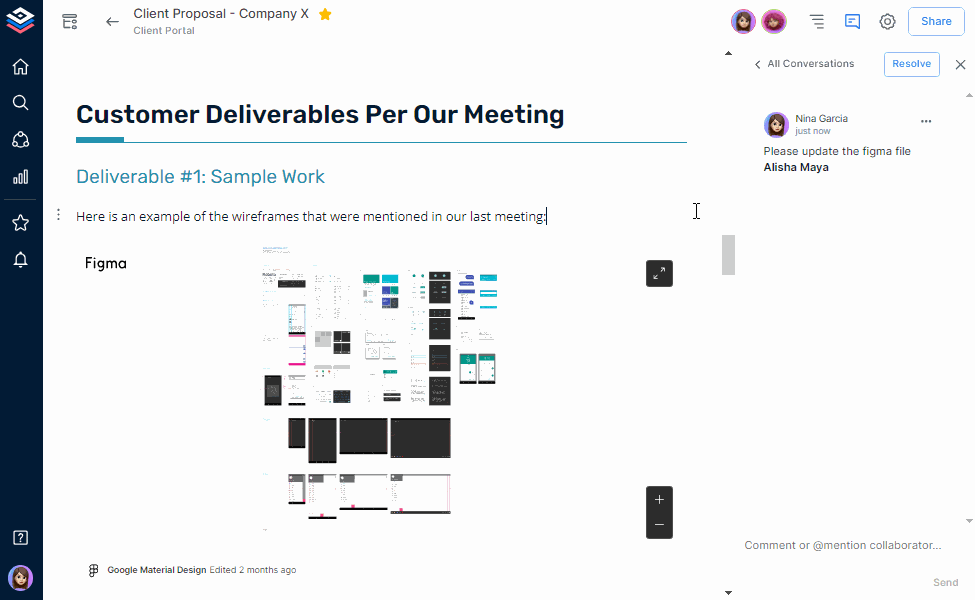
✔ AI Genius Writer
Use Bit.ai’s AI Genius Writer to generate customized content, outlines, emails, research briefs, and pros/cons lists. You can leverage its ability to write your content with 300+ pre-embedded prompts and translate your input into many languages and formats, including tables, bullet points, quotes, etc, to get immediate professional-quality documents.
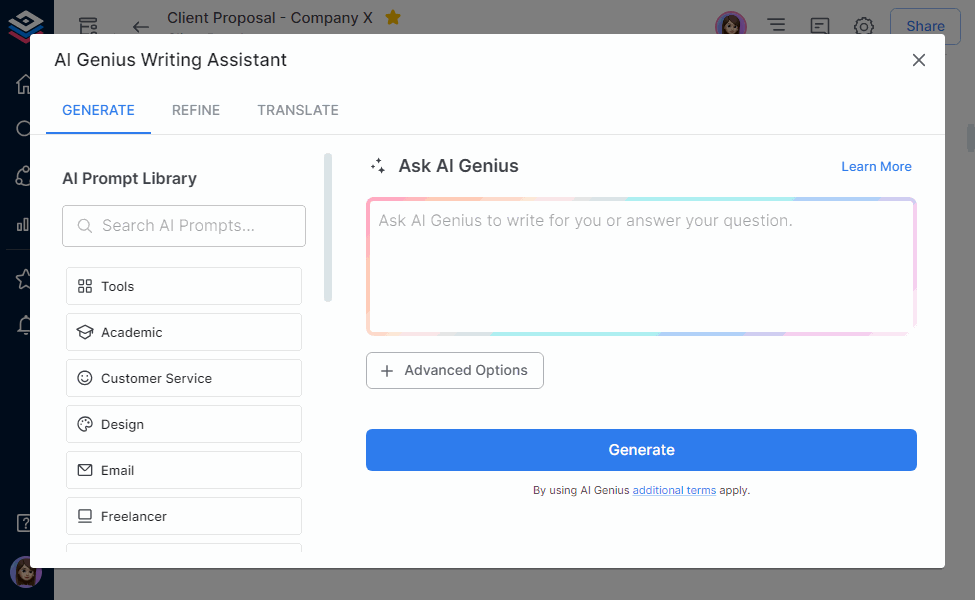
✔️ AI Doc Builder
Bit.ai’s AI Document Builder helps you create fully structured, professional documents from scratch in minutes. Simply provide your ideas or input, and it automatically generates well-organized documents, complete with headings, bullet points, tables, and summaries.
✔️ Rich Media & 100+ Integrations
You can embed over 100 content types (including Figma, Google Sheets, Typeform, videos, code blocks, etc) in addition to your documents with 100+ app integrations. “Living documents” update in real-time, giving your team dynamic and up-to-date insights at a glance.
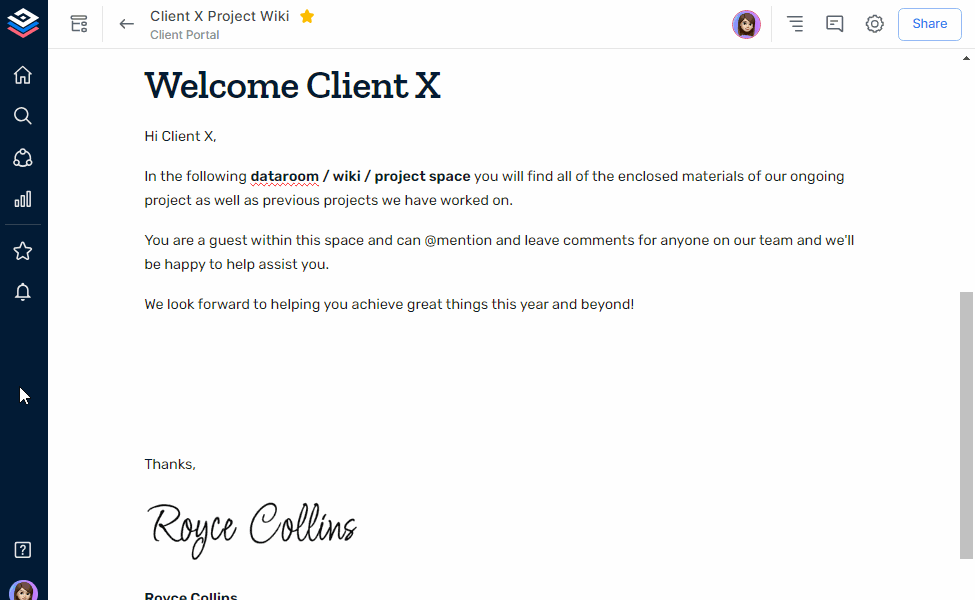
✔️ Professional Templates
Start faster with Bit.ai’s extensive library of pre-built templates for reports, proposals, meeting notes, and more. These professional templates save time, maintain consistency, and make it easy for teams to produce professional documents without starting from scratch.
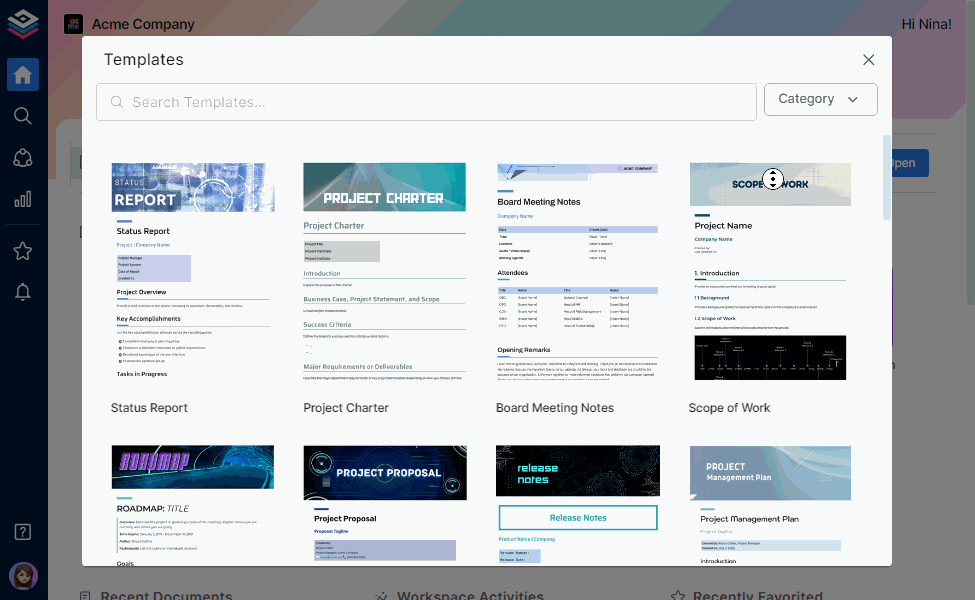
✔️ Advanced Sharing
You can share content through live links that are constantly updated in real-time, trackable links that let you observe how many people are making changes to the content. There are even more features, including password protection to view a document, link expiration, and guest login controls.
✔️ Smart Wiki & Knowledge Base
At Bit.ai, it’s simple to manage and grow your team’s knowledge with unlimited wikis inside spaces. Whether it’s company policies, project docs, or training guides, everything is kept organized, structured, and accessible.
💸Pricing: Free Plan & Paid Plans Starting at ~$8/user/month
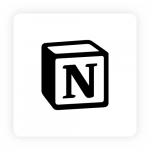 #2. Notion
#2. Notion
Notion combines databases, note-taking, and simple project management. It is still a favorite for small teams and creative workflows since it is adaptable and templated. It comes in the form of an open teamwork tool with powerful task and note features. It is focused on presenting the possibility of consolidating docs and discussions by teams, which makes it a great product to collaborate on specific content.
Key Features:
- Unlimited content: Create as many pages and content blocks as you need for docs, project hubs, and more, all in one place.
- Easy collaboration: Invite guests to work with you and manage team permissions to stay in control.
- AI features: Business and Enterprise plans include built-in AI to help with writing, summarizing, and organizing.
- Tool integrations: Connect Notion with tools like Slack, GitHub, and Google Drive to streamline your workflow.
- All-in-one workspace: Everything you need to plan, write, share, and manage projects is together in Notion.
💸Pricing: Free Plan & Paid Plans Starting at ~ $10/user/month (annual) or $12 monthly.
🟪 Quick Fact: The global document collaboration software market is projected to reach $5.25 billion in 2025, with a CAGR of about 7 % through 2033.
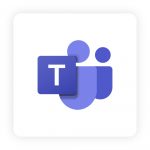 #3. Mircosoft Teams
#3. Mircosoft Teams
Microsoft Teams can be considered the powerhouse in chat, video, file sharing, and integration with Office. Best for organizations encased in Microsoft 365. This one is a no-brainer that teams are constructed to manage teams powerfully, communicate through messaging and video conferencing, and share files in real-time. It can be called a full-featured online collaboration system.
Key Features:
- All-in-one collaboration: Chat, video/audio calls, and screen sharing all happen in one place, making teamwork easy in real time.
- Microsoft 365 integration: Works smoothly with Word, Excel, PowerPoint, and SharePoint, so you can create, edit, and share documents without switching apps.
- Real-time co-editing: Collaborate live on the same document right inside Teams, or share files through SharePoint and keep the conversation going in Teams.
- Secure meetings: Built-in encryption helps keep meetings safe, whether you’re talking to teammates or external guests.
- Extra tools for teams: Features like guest access, shift scheduling, and shift swapping make it useful for both office and front-line staff.
💸Pricing: Free Plan & Paid Plans Starting at ~ $4/user/month
 #4. ClickUp
#4. ClickUp
ClickUp itself is called the “everything app, ” since it has tasks, docs, chat, whiteboards, and even AI built in, and is attempting to replace several disparate tools. It is designed as an end-to-end project and collaboration solution, making it possible for teams to manage work from start to finish in one place. Users can assign and track the status of tasks, collaborate on documents live, brainstorm on whiteboards, chat with team members in group chats, and even use AI to help write, summarize, or plan faster. ClickUp is built to manage everything from everyday tasks to planned projects, all in one app, without jumping around.
Key Features
- All-in-one workspace: Manage tasks, docs, whiteboards, and team chat all in one place.
- Custom project views: Choose how you see your work: Kanban boards, lists, Gantt charts, calendars, and more.
- Flexible collaboration: Invite guests and control permissions so clients and teammates can collaborate securely.
- AI add-on available: Optional AI helps with writing, summarizing, and automating repetitive work.
- Built for any workflow: Whether you’re planning, building, or tracking, ClickUp adapts to how your team works.
💸Pricing: Free Plan & Paid Plans Starting at ~ $7/user/month
 #5. Slack
#5. Slack
Slack is a popular real-time messaging and communication platform for startups and enterprises alike. Slack’s platform is built to keep teams connected and productive, regardless of where a person works from. Slack is intuitive and supports direct messages, group chats, file sharing, voice and video huddles, and AI-generated summaries. The platform also integrates with over 2600 apps (including popular options like Google Drive, Zoom, and Jira); therefore, Slack is a great tool for centralizing notifications and automating workflows. With Slack AI, conversational threads and action items can be summarized in seconds–a great solution for teams tired of excess meeting time. Whether you have a fast-paced startup or a large, global enterprise, Slack scales to your team’s needs and grows as needed for your tech stack.
Key Highlights:
- Organized communication: Use channels, threads, and DMs to keep team conversations focused and easy to follow.
- Huge app ecosystem: Integrates with 2,600+ tools like Google Drive, Office 365, Salesforce, and more.
- No-code automation: The built-in workflow builder helps automate tasks without needing to code.
- AI-powered features: Includes thread and meeting summaries, message translations, and smart agents (Agentforce) to boost productivity.
- Customizable setup: Teams can tailor Slack to fit how they work, whether it’s internal chat or client-facing support.
💸Pricing: Free Plan & Paid Plans Starting at ~ $2.86/user/month.
Each tool does some things better than others, so the decision can depend on your team and its needs and workflows. Now, let’s start to tie it up!
🚀 Ready to collaborate smarter? Try Bit.ai and keep all your team’s docs in one place.
Wrapping Up
The right collaboration tool has the capability to change the way your team operates, streamlining workflow into an efficient, goal-directed, and productive workflow. It can be business proposals, organizing content, and launching a product, but the important thing is to have the right platform for content collaboration and document sharing.
Spend some time experimenting with a few tools, check with your colleagues what they want, and select one that fits like a glove into what you are already doing.
Ultimately, the most effective tools are the ones that leave your team to shine. Happy collaborating!
FAQs
What do team collaboration tools do?
They allow teams to communicate, share files, distribute responsibilities, and work on the content at the same time, and thus facilitate the process of work and make it quicker.
What are the differences between project collaboration and content collaboration?
Content collaboration centres on document creation and editing. Task tracking and deadline management are some of the broader workflows that are part of project collaboration.
What is the way to work on a document as a team?
With such a document collaboration tool, teammates are also in a position to edit, comment, and provide feedback on the same document in real-time, with version history and permissions.
What is document sharing and document collaboration?
Sharing of documents enables other people to view or access a file. Multiple people can concurrently edit, read, and comment on a document when co-editing is used in conjunction with document collaboration.
Keep Reading & Learning 📚
- Why Teamwork Is The Key To Success And Growth
- Top Team Engagement Activities to Improve Workflow
- Collaborative Teamwork: The Best Approach for Your Tea
- How Bit.ai Can Improve Your Team Collaboration?
- Communicate Effectively: How to do it in Workplace! (Types & Techniques)
- The Benefits & Drawbacks of Working Remote (WFH)
- 21 Remote Work Tools & Apps For Productive Employees!
